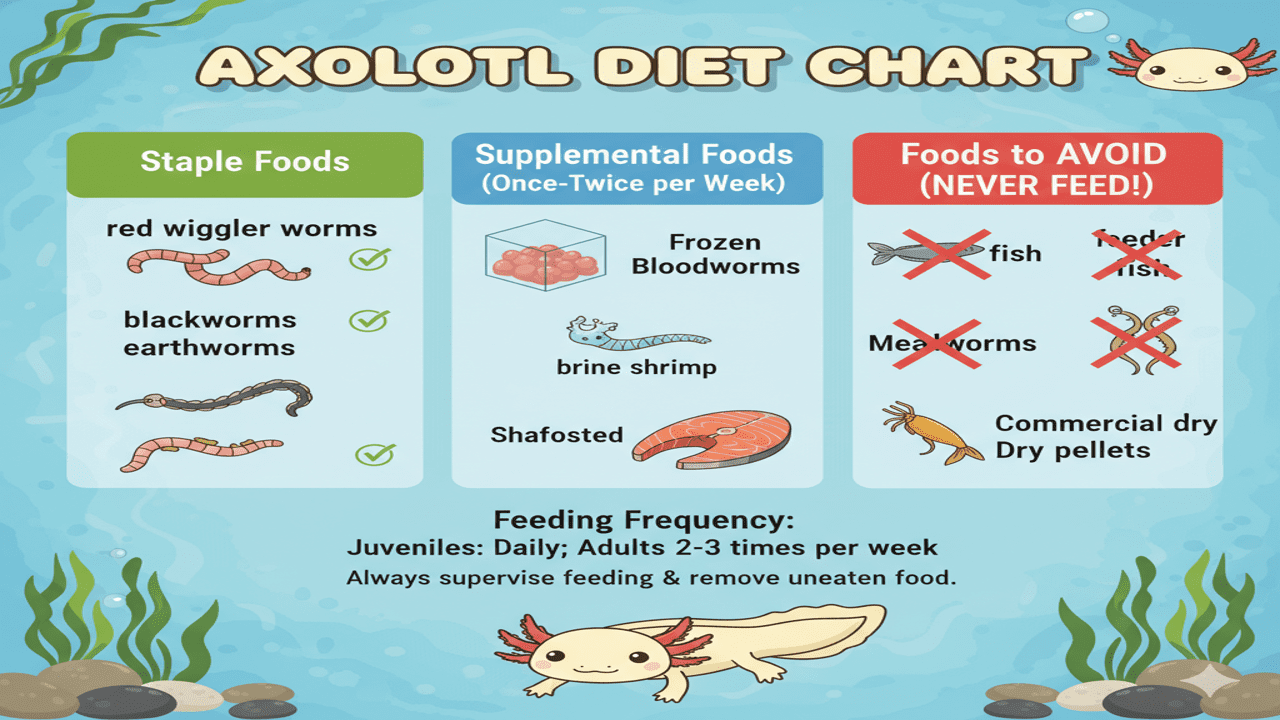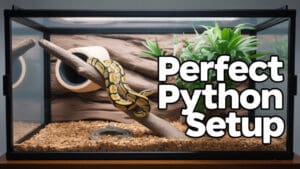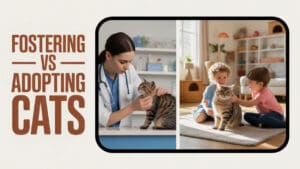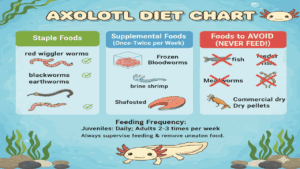Axolotl Diet Chart (2025): Expert Tips on Age-Based Feeding, Live Foods, Safe Choices, and Mistakes to Avoid
You think feeding your axolotl is just about dropping food into their tank? It’s not that simple. You’ll need to give your little guy the right nutrition at the right time in order to keep them healthy and, of course, living a long life.
Though axolotls may often be good at self-regulating their food intake, we should follow an age-specific axolotl diet chart. With this, you should know better to give your fast-growing juvenile their protein-rich meals every day. And you’ll be more aware that your fully grown adult axolotl can thrive on just two or three feedings a week.
Now, many of us (guilty as charged) rely too heavily on pellets or generic fish food. These aren’t ideal for your exotic pet. They do not have the nutrient density other options do (e.g. earthworms, bloodworms, and brine shrimp).
Let’s take a look at some expert-backed portion guidelines in this article. We’ll also take a look at how your axolotl’s diet has shifted from wild to captive environments. Additionally, we’ll check out some of the risky moves to avoid when it comes to feeding your little friend, like steering away from goldfish or hard-shelled insects.
So, learn to avoid the common feeding mistakes. And you shall have a wonderful amphibian companion for years to come.
Quick-Reference Axolotl Feeding Chart
| Life Stage | Age | How Often | Best Foods | Portion Size (per feeding) |
| Hatchling | Less than 3 months | 2–3 times a day | Baby brine shrimp, daphnia, micro worms | As much as they can eat in 5–10 minutes |
| Juvenile | 3–6 months | Once a day | Chopped earthworms, bloodworms, small pellets | About the size of their head (one worm piece) |
| Sub-Adult | 6–12 months | Every other day | Whole earthworms, pellets, occasional shrimp | 1–2 medium earthworms |
| Adult | 12 months+ | 2–3 times a week | Earthworms, nightcrawlers, pellets, variety foods | 2–3 large earthworms |
Note: Feeding frequency and portions may need adjusting depending on water temperature and your axolotl’s appetite.
Axolotl Diet Chart: Understanding Axolotl Dietary Needs
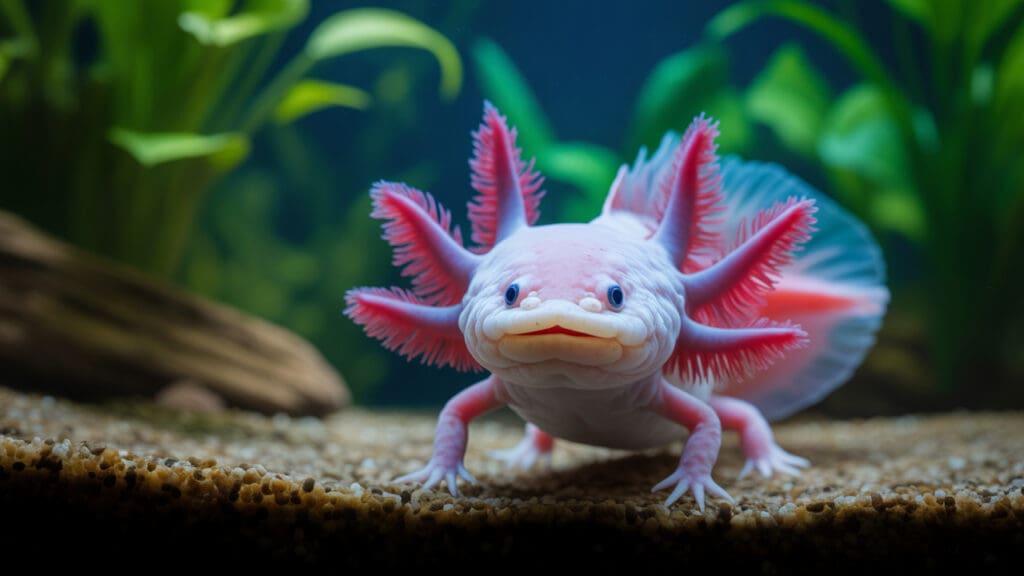
Your axolotl’s diet will directly affect their growth, health, and lifespan. This is one of the most important aspects you’ll need to look into when taking care of these little ones.
In the wild, axolotls are opportunistic carnivores. That means they take advantage of what they can fit into their mouths, like small fish and crustaceans. So, they can get enough nutrients based on their own efforts.
For axolotls in captivity, you’ll need to provide this high-protein, nutrient-rich diet. It’s important to maintain their health and natural behaviors. That said, remember that your little pal thrives on a variety of safe foods. And they should match their developmental stage and energy needs.
Be careful not to overfeed your axolotl or rely on the wrong food types. This can very well lead to obesity and poor water quality. And worst of all, it could cause your pet digestive problems. Exotic pet vets say that an ideal diet should involve something that’s easily digestible with high-protein sources.
So, consider using a mix of earthworms, bloodworms, brine shrimp, and quality sinking carnivore pellets. These foods have the essential amino acids and micronutrients your axolotl needs. And you won’t worry about them adding excessive fat. Remember, variety is key. Don’t just rely on feeding only one type of food. It can still cause nutritional imbalances over time.
Axolotl Feeding Chart by Age
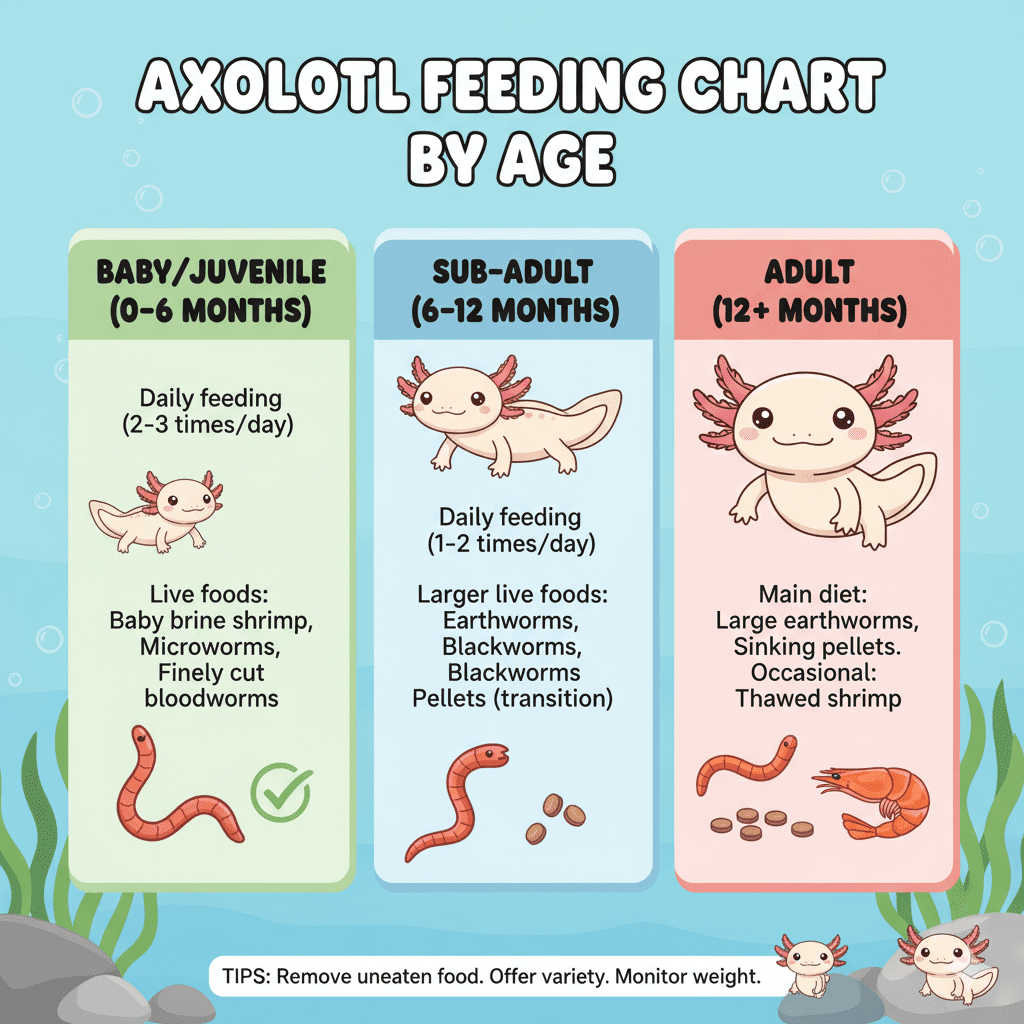
Nope, you can’t always feed the same amount of food for axolotls of all ages. Your baby amphibian needs something different from what an adult one needs.
So, have an axolotl diet chart ready to help you manage portion sizes and feeding frequency. These charts should tell you what types of food your axolotl needs depending on their growth stage. The main thing is to support the growth of the young to help them grow into healthy adults with vitality.
Now, for a hatchling or your juvenile axolotl under six months, you’ll need to feed them every day. At this stage, their metabolism is fast, so they’ll need frequent, small meals. Provide them with live or frozen foods like baby brine shrimp, daphnia, or chopped earthworms.
Do not overload them with too much food all at once. Be patient and monitor. Otherwise, the water quality will turn poor quickly, and this can impact your pet’s health. Experts recommend feeding what they can eat within 3-5 minutes to avoid much waste.
For axolotl aged six months to about a year (the subadult phase), you should feed them once a day or every other day. Now, here’s when you can give them larger portions of food. Consider earthworms, bloodworms, and quality sinking pellets.
But be careful not to switch to the adult feeding schedule too soon. It could slow their growth and cause nutritional deficiencies. Think of this stage as a training period for your little one’s digestive system.
And then, for your adult axolotl (usually over a year old), you just need to feed them two to three times per week. That said, their diet should focus on high-protein, low-fat foods. Occasional fasting is good for your pet at this stage. It mimics their natural feeding patterns (like on days they can’t catch prey) and prevents them from becoming obese.
In any case, get yourself an axolotl feeding chart for beginners if you’re in doubt. It can help you avoid overfeeding your amphibian friend and keep track of the meal variety.
The Axolotl Body Condition Score: Are You Over- or Underfeeding?
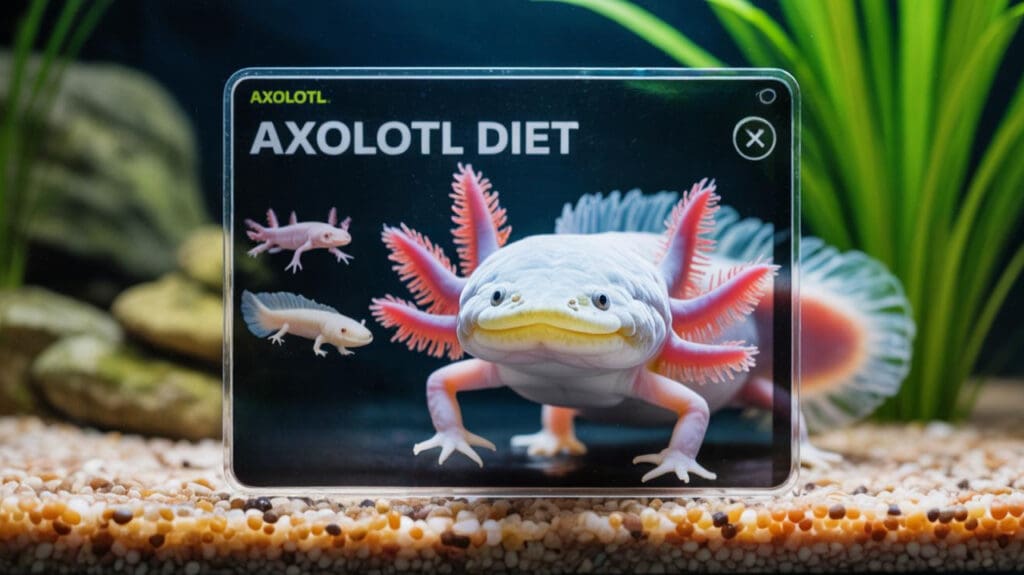
How to Tell if Your Axolotl is a Healthy Weight
Use this simple 1–5 scale to check your axolotl’s body condition:
1. Emaciated
- Head is much wider than the body
- Belly is very sunken
- What to do: Feed more often and consult a veterinarian immediately
2. Underweight
- Body is slightly narrower than the head
- Belly stays flat even after eating
- What to do: Increase portion size or feeding frequency slightly
3. Ideal (Healthy)
- Body width matches the head width when viewed from above
- Belly is slightly rounded after eating but flattens between meals
- Goal: Maintain this condition
4. Overweight
- Body is wider than the head
- Belly stays rounded all the time
- What to do: Reduce feeding by one session per week
5. Obese
- Fat deposits visible behind the legs
- Body is much wider than the head
- What to do: Follow a strict feeding schedule and consult an exotic veterinarian
Quick Visual Tip: From above, a healthy axolotl looks like a straight line from head to tail. Underweight axolotls look more like a lightbulb shape, while overweight ones resemble a pear shape.
Axolotl Diet List: What Live Food Can Axolotls Eat?
Now, you want to keep your axolotl stimulated so that they can be active, engaged, and stress-free. One way to do so is to provide them with live food. It keeps their natural hunting instinct and contains essential protein and micronutrients.
But you might be asking the same question most people are asking. What live food can I feed my axolotl? After all, you want to meet both their nutritional and behavioral needs.
Possibly the most popular choice for experienced owners out there is earthworms. They are dense in nutrients and can be cost-effective. You can even raise them at home if you want to. And they are easy for your axolotl to digest.
Next, we have bloodworms, both live or freshly thawed. These are great for your juvenile axolotl as they have a softer texture to help your young friend develop their jaws.
Daphnia and brine shrimp are also great choices for hatchlings and smaller axolotls. They can provide your little guy with high protein without overloading the digestive system.
Now, feeder fish like guppies can be used sometimes. But know that they can carry parasites. You need to make sure that you get them from trusted, quarantine-controlled sources.
If you want more options, you can try freshwater ghost shrimp, blackworms, and small snails. That said, you should only feed these in moderation.
Axolotl Diet Chart: Comparing an Axolotl’s Diet in the Wild vs. in Captivity
In the wild, axolotls are stealthy ambush predators. You might have seen in documentaries that they lurk motionless until their prey comes close enough for them to attack and gulp down.
These wild amphibians naturally have a diverse menu. These include small fish, insect larvae, crustaceans, mollusks, and worms. Anything that can fit into their mouths can be a food source, basically.
Such an axolotl diet in the wild helps them receive a good range of nutrients. And this feeding pattern will change based on seasons, the availability of prey, and the water temperature.
Your axolotl at home, however, will need to rely completely on you to provide them with the same diverse nutrients. Now, even if the axolotl diet in captivity is highly nutritious, feeding can become monotonous if you’re just using one single food source.
So, rotate between the options mentioned (like earthworms, bloodworms, brine shrimp) and introduce treats like ghost shrimp or safe feeder fish sometimes.
When done right, controlled feeding removes the risks of parasites or toxins-something that wild axolotls have to face. But this also means you’ll need to invest in sourcing or even cultivating fresh, high-quality live food. You could try to maintain a home worm farm or brine shrimp hatchery to cut long-term food costs.
An axolotl’s diet and habitat are also intertwined. Wild axolotls can get different food sources depending on seasonal shifts, making them hunt in different ways. Your little one at home may need more enrichment. So, try varying the feeding times and let them hunt for live food. This can help them prevent boredom.
2025 Feeding Enrichment: Make Mealtime More Fun
Feeding your axolotl can be more than just a bowl of food – you can add enrichment to stimulate natural hunting behavior.
Try a Simple Feeding Puzzle:
- Use a clean, food-safe PVC pipe and drill holes in different spots.
- Place live blackworms or bloodworms inside the tube.
- Your axolotl will have to work to get the food, just like it would in the wild.
Benefits:
- Encourages exercise and activity
- Prevents boredom
- Makes feeding more engaging
Tip: Always supervise at first to make sure your axolotl learns to access the food safely.
Axolotl Diet Chart: Safe and Unsafe Foods for Axolotls
Now, it’s great that you’re starting to incorporate different food sources into your axolotl’s diet. But you also know what’s safe and what’s risky to them. Just because your little one is an opportunistic feeder doesn’t mean it’s safe for them to swallow everything.
The safest options are earthworms, bloodworms, brine shrimp, daphnia, and high-quality sinking carnivore pellets. These foods can provide your axolotl with a good balance of protein and essential nutrients. And your little one can digest them easily.
You can also give your axolotl occasional treats like ghost shrimp or small, parasite-free feeder fish. But make sure that the live fish you source from is quarantined. And buy them from reputable suppliers. You don’t want to be dealing with diseases. Also, exotic pet vets recommend that we gut load the live prey before feeding them to our pet.
As for unsafe foods, first, avoid fatty meats. Do not feed your axolotls beef or chicken. It can cause liver damage over time. You should also avoid insects with hard exoskeletons, like mealworms. They are quite difficult for your pet to digest, and that may cause impaction.
Don’t feed your axolotl larger feeder fish like goldfish. They usually have a high parasite risk. And they also contain thiaminase, an enzyme that can cause vitamin B1 deficiency.
You might want to ask this question next. Can axolotls eat fish food? Well, yes, technically. But generic fish flakes or tropical fish pellets are not ideal for your little one. They do not have the nutrient density and protein levels needed.
Step-by-Step: How to Feed Your Axolotl Safely
The way you feed your axolotl matters for their safety and your convenience. Here are the three main methods:
Method 1: Feeding Tongs (Recommended)
Why Use Tongs:
- Keeps substrate (sand or gravel) out of their food
- Allows precise feeding
- Lets you wiggle food to trigger hunting instincts
- Keeps your hands clean and dry
How to Feed:
- Use blunt, rounded tongs made for aquariums
- Hold the food gently but securely
- Wiggle the food near your axolotl’s face, especially around their nose and gills
- Let them grab it naturally
- Remove any uneaten food right away
Tip: Avoid sharp tongs-they can hurt your axolotl’s mouth.
Method 2: Feeding Dish (For Pellets or Chopped Worms)
Why Use a Dish:
- Keeps the tank clean
- Makes it easy to remove uneaten food
- Prevents mixing food with substrate
How to Feed:
- Use a shallow terracotta or glass dish
- Place it on bare bottom or fine sand
- Put food in the dish
- Train your axolotl to recognize the dish as feeding time
- Remove and clean the dish after feeding
Method 3: Hand Feeding (For Experienced Owners Only)
Why Use Hands:
- Gives direct control over feeding
- Lets you respond immediately to your axolotl’s appetite
Risks:
- Accidental bites
- Oils or residue from your hands can harm axolotls
- Requires extra care and hygiene
How to Feed:
- Wash hands thoroughly with dechlorinated water only
- Hold food between thumb and forefinger
- Present food near your axolotl’s mouth
- Be patient – they have poor eyesight
- Wash hands again after feeding
Axolotl Diet Chart: Common Feeding Mistakes and How to Avoid Them
Even if you try to do everything out of love and good intentions, there’s no telling if what you’re doing might harm your axolotl’s health. So, let’s look at the axolotl diet facts and identify some pitfalls early to keep your little one thriving for years.
One mistake many of us make is overfeeding our axolotl. You see, our little amphibian friend will almost always try to put food in their mouth whenever they see some. It’s a misleading act that makes us think that they’re hungry. So, don’t use that as a cue.
Instead, exotic pet vets suggest we portion the meals so that our little friend can fully consume the food within two to three minutes. That said, there’s a need to adjust the feeding frequency according to your axolotl’s age and water temperature.
Know that overfeeding can cause your axolotl to become obese or even develop digestive issues. The excess waste left behind can even deteriorate the water quality.
The next mistake is giving the wrong food type. Remember not to rely on generic fish flakes or tropical fish pellets. They may be convenient, but they are certainly not nutritious. Think of them as occasional supplementation to reduce boredom in terms of food variety. Avoid feeding your pet hard-shelled insects, too.
Troubleshooting: My Axolotl Won’t Eat!
If your axolotl refuses food, follow this guide to find the cause and fix it.
| Problem | Possible Cause | Solution |
| Spits out food | Food is too big | Cut worms or pellets into smaller pieces |
| Ignores food completely | Water too warm (above 68°F / 20°C) | Cool tank to 60–64°F (16–18°C) using fans or a chiller |
| Shows no interest | Stress from poor water quality or bright light | Test water for ammonia, nitrites, and nitrates; provide hiding spots |
| Recently stopped eating | Possible impaction from gravel ingestion | Switch to fine sand or bare bottom; monitor for 48 hours |
| Won’t eat for over a week | Illness (fungal or bacterial infection) | Quarantine and consult an exotic veterinarian |
| Female refusing food cyclically | Egg reabsorption period | Normal; may skip meals for up to a month |
First Steps: Always check water temperature and quality first. Temperatures above 72°F (22°C) or presence of ammonia/nitrites can stop feeding.
Emergency Test: Offer live blackworms or wiggle frozen bloodworms with tongs. If your axolotl refuses these, the problem is likely environmental or health-related, not a preference for food.
FAQs About Axolotl Diet and Feeding Habits
Many of us share the same questions when it comes to feeding your axolotl right. Getting things right could mean a world of difference for your pet’s health and longevity. Below are ten of the most frequently asked questions that you might want to know to get started on your routine.
1. What is the best diet for an axolotl?
A balanced diet for your amphibian friend includes protein-rich (live or frozen) foods. These should be a combination of earthworms, bloodworms, and brine shrimp. On occasion, you can also introduce safe feeder fish (not a main meal) to break the mundane cycle.
2. How many times does an axolotl eat a day?
Your juvenile axolotl usually needs to eat once or twice every day. For adults, you just need to feed them two to three times per week.
3. Can axolotls go 4 days without food?
Assuming that your axolotl is healthy, an adult one can go up to 2-3 weeks without food. However, never think this is the case for your juvenile or growing axolotl.
4. Can you overfeed an axolotl?
Yes. Overfeeding is quite common. And it can lead to obesity, water quality issues, and digestive problems. You should aim to give your little guy only what they can handle within two to three minutes.
5. How many earthworms to feed an axolotl?
Depending on their size, your adult axolotl may need to eat one to three medium earthworms per feeding session.
6. What live food can axolotls eat?
Some of the best options out there include earthworms, bloodworms, brine shrimp, daphnia, ghost shrimp, and small parasite-free feeder fish. Rotate them for nutritional balance.
7. What foods should be avoided in an axolotl diet?
You should always avoid fatty meats and large, aggressive fish. Also, do not feed your axolotl insects with hard shells. They might cause impaction.
8. How does an axolotl’s diet change with age?
Remember that your young axolotl needs frequent, small protein-rich meals. Your adult one, on the other hand, needs fewer feedings. But you need to make sure the protein sources are of high quality.
9. Can axolotls eat fish food pellets?
Yes. If you’re using high-quality sinking carnivore pellets, they are good for supplementation. But they shouldn’t replace live or frozen foods entirely.
10. Why is live food important in an axolotl diet?
Live food provides essential nutrients. And the hunting effort stimulates natural hunting instincts, keeping your axolotl active and engaged.
Axolotl Diet Chart: Keeping Your Axolotl Healthy Through Smart Feeding
If you want to meet your pal’s nutritional needs, make sure you understand their age-specific diet. Certainly, having an axolotl diet chart can help tremendously.
Remember to offer your amphibian friend a good variety of high-protein food, be it live or frozen. Also, steer clear of common mistakes like overfeeding or relying on nutrient-poor pellets. Stick to the portion size recommended by experts and adjust the feeding frequency based on your axolotl’s growth.
Know that by taking these steps, you’re building a great foundation for your amphibian for a long, active, and stress-free life. Now, be confident about your meal choices and go on to enjoy your time with your thriving aquatic companion.
What’s your axolotl’s favorite food? Are there any unique feeding tricks you can share with us? Let us know in the comments down below!

